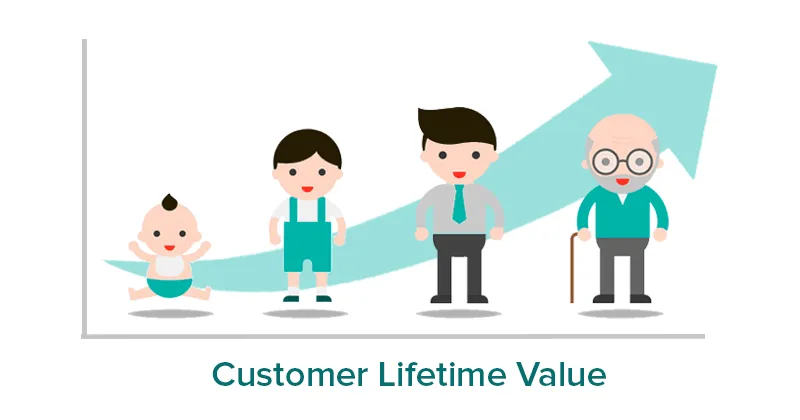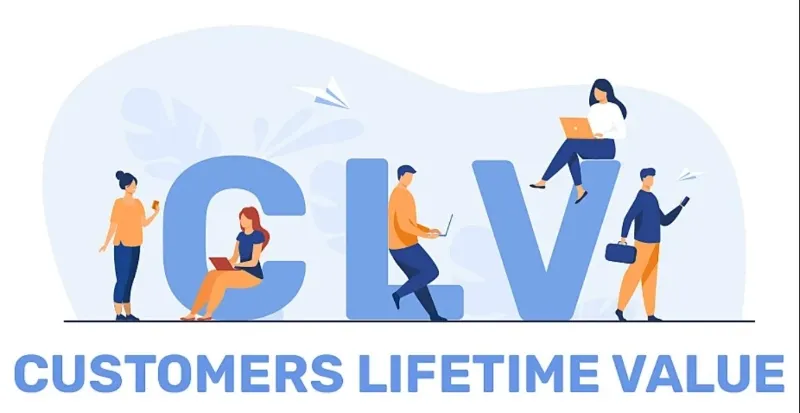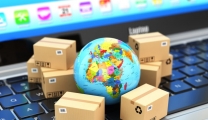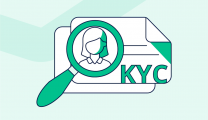What is Customer Lifetime Value?
Customer lifetime value is a metric that measures the total amount of money a customer will spend with your business over the course of their lifetime. It takes into account the initial purchase as well as any repeat business, referrals, and other factors that contribute to a customer's overall value to your business.
Calculating CLV involves estimating:
- The average purchase value
- The number of purchases per year
- The average customer lifespan (in years)
Here's an example: Let's say your average customer spends $100 per purchase, makes 2 purchases per year, and has a lifespan of 5 years. Their CLV would be $1,000 ($100 x 2 x 5).

What is Customer Lifetime Value?
Why is Customer Lifetime Value Important?
Maximizing CLV is important because it can help you increase revenue and profitability. By focusing on retaining existing customers and increasing their lifetime value, you can reduce customer acquisition costs and improve your return on investment.
Additionally, customers with high CLV are more likely to refer new customers to your business, which can help you expand your customer base and grow your business.
- CLV by Industry
CLV can vary widely depending on the industry you're in. Here's a look at CLV by industry
- E-commerce
E-commerce businesses often have high CLV due to the ease of repeat purchases and the potential for subscription-based models. According to Shopify, the average CLV for an e-commerce business is $72.
- Retail
Retail businesses generally have lower CLV than e-commerce due to greater competition and lower profit margins. According to a study by the National Retail Federation, the average CLV for a retail customer is $1,704.
- SaaS
Due to the recurring revenue model, software as a service (SaaS) businesses often have high CLV. According to a report by Totango, the average CLV for a SaaS business is $3,000.
- Finance
Finance businesses such as banks and credit card companies often have high CLV due to the long-term nature of financial products. According to a study by Bain & Company, the average CLV for a banking customer is $2,500.

Why is Customer Lifetime Value Important?
How to Maximize Customer lifetime value
Now that you understand CLV by industry, let's explore some tips for maximizing your CLV:
1. Provide excellent customer service
Customers who feel valued are more likely to continue doing business with you. Providing excellent customer service can help you build strong relationships with customers and increase their loyalty to your brand.
2. Offer personalized experiences
Personalization can help you create a unique experience for each customer, which can increase their satisfaction and loyalty. Use data and analytics to understand your customers' preferences and tailor your offerings to meet their needs.
3. Implement a loyalty program
Loyalty programs can incentivize customers to make repeat purchases and refer new business to your company. Consider offering rewards for purchases, referrals, and other desired behaviors.
4. Focus on retention
Retaining existing customers is often more cost-effective than acquiring new ones. Focus on providing a great experience for current customers to encourage them to continue doing business with you.
5. Use data and analytics
Data and analytics can help you understand your customers' behavior and identify opportunities for increasing CLV. Use tools like customer relationship management (CRM) software and marketing automation to track customer interactions and personalize your communications.

How to Maximize CLV
Pros and Cons of Maximizing Customer Lifetime Value by Industry
Pros:
- Increased Profits: Maximizing customer lifetime value can lead to increased profits for businesses by encouraging repeat purchases and increasing customer loyalty.
- Improved Customer Retention: Focusing on customer lifetime value can help businesses improve customer retention rates, as it emphasizes the importance of building long-term relationships with customers.
- More Accurate Budgeting: By understanding the lifetime value of their customers, businesses can better allocate their marketing and advertising budgets and make more informed decisions about where to invest their resources.
- Better Customer Service: Maximizing customer lifetime value can lead to better customer service, as businesses are more likely to prioritize the needs and preferences of their loyal customers.
Cons:
- Potential for Short-Term Thinking: Focusing solely on customer lifetime value can lead to short-term thinking, as businesses may prioritize quick profits over long-term sustainability.
- Risk of Overlooking New Customers: While maximizing customer lifetime value is important, businesses also need to focus on acquiring new customers in order to continue growing.
- Limited Focus on Customer Satisfaction: Maximizing customer lifetime value can sometimes lead businesses to overlook the importance of customer satisfaction and meeting the needs of individual customers.
- Difficulty in Measuring Success: Measuring the success of a customer lifetime value strategy can be challenging, as it requires businesses to track the long-term behavior of their customers and compare it to their initial investment in acquiring them.

Pros and Cons of Maximizing CLV by Industry
The Best Tools for Maximizing CLV
There are many tools available to help you maximize your CLV. Here are a few of the best:
HubSpot CRM is a powerful tool for managing customer relationships and tracking interactions across multiple channels.
Optimizely is an A/B testing platform that allows you to test and optimize your website and other digital experiences.
Klaviyo is an email marketing platform that specializes in personalized, data-driven communications.
Smile.io is a loyalty program platform that allows you to incentivize customers with rewards and points for desired behaviors.
Google Analytics is a free tool that provides insights into website traffic, user behavior, and other important metrics.












Replies to This Discussion